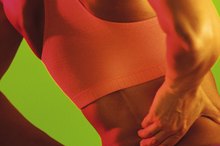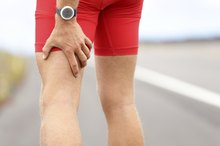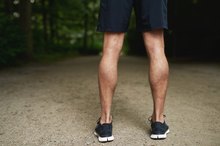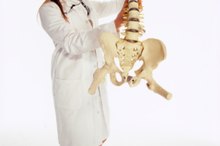Lactic Acid, Soreness & Potassium
Generally, when people refer to soreness, they’re talking about muscle pain -- and when you exercise, muscle soreness can happen for a number of reasons. While lactic acid may be involved in muscle pain, it’s not a factor in all muscle soreness. Additionally, potassium levels can be a cause or treatment for soreness.
Delayed Onset Muscle Soreness versus Lactic Acid
During exercise, your muscle cells may need more oxygen as fuel than is readily available. When this happens, your body begins to convert other substances into lactic acid as a substitute. This lactic acid accumulates within your muscle cells and can cause temporary, painful burning sensations in your muscles.
Another type of soreness isn’t felt until about 24 hours after exercise and is called delayed onset muscle soreness (DOMS). Once mistakenly thought to be caused by lactic acid buildup, DOMS is actually caused by the tearing of muscle fibers at the microscopic level. DOMS is also a temporary condition.
While lactic acid buildup (LAB) and DOMS are uncomfortable, they are not serious medical problems, and they can be viewed positively from the prospective of physical conditioning. This is because both LAB and DOMS are indications that you are challenging your body, moving progressively beyond a previous fitness threshold. Additionally, "Scientific American" reports that LAB actually prevents serious muscle damage during overexertion.
Potassium
Lactic Acid, Soreness & Potassium
Learn More
Temporary muscle pain can also be caused by a low level of potassium in your bloodstream. This is because potassium is a mineral that serves as an electrolyte. An electrolyte carries an electric charge and helps regulate a variety factors, such as your blood’s acidity level, your body’s overall water level and your muscle function. Electrolytes, such as potassium, are lost when you sweat. If electrolytes are not replaced, imbalances occur and muscle pain is then a symptom of inadequate potassium levels.
Treatment and Prevention
When you slow down or stop your physical activity, the painful burning sensations caused by lactic-acid buildup dissipates – so no further treatment is required. However, by progressively becoming more physically fit, your body will become more efficient at managing its fuel, thus reducing the occurrence of lactic acid buildup.
DOMS usually lasts for about 3 to 5 days. The American College of Sports Medicine reports that pain symptoms may be alleviated through various treatments ranging from over-the-counter pain relievers, ice packs and massage. While you may not be able to completely prevent DOMS, you can minimize potential soreness by gradually weaning and pacing yourself during exercise, allowing your muscles to adapt more efficiently.
At-home treatment and prevention for muscle soreness caused by potassium imbalances includes replenishing and managing your potassium levels through proper water hydration before, during and after exercise; consuming electrolyte-enriched drinks; or eating foods that are naturally high in potassium, such as potatoes (with the skin) and bananas.
Medical Attention
How to Treat Severe Muscle Soreness From Weightlifting
Learn More
The Mayo Clinic reports that you should seek medical care if your muscle pain lasts more that a week. If, in addition to pain, you experience dizziness, nausea and trouble breathing, the Mayo Clinic advises that you get medical attention immediately.
Related Articles
References
- Scientific American: Why Does Lactic Acid Build Up in Muscles? And Why Does It Cause Soreness?
- American College of Sports Medicine: Delayed Onset Muscle Soreness
- NIH MedlinePlus.com: Muscle Pain
- NIH MedlinePlus.com: Electrolyte
- Bicycling: Lactate Threshold 101
- ABC-of-Hiking: Lactic Acid Build Up
- Linus Pauling Institute: Potassium
- American College of Sports Medicine: Selecting and Effectively Using Hydration for Fitness
- MayoClinic.com: Muscle Pain - When to See a Doctor
Writer Bio
This article was written by the CareerTrend team, copy edited and fact checked through a multi-point auditing system, in efforts to ensure our readers only receive the best information. To submit your questions or ideas, or to simply learn more about CareerTrend, contact us [here](http://careertrend.com/about-us).









